What do we know about the pear
Pear is a fruit tree from the rose family. In the wild, it does not grow in Europe and Asia. For several millennia, it has been grown in gardens. The fruits of this tree are tasty and healthy, easy care for them. Hundreds of varieties have been developed that can be grown in a wide variety of latitudes. Breeding work is still in progress.
- Main characteristics
- Description of pear
- Description of fruits
- Pear composition
- The benefits and uses of pears
- Planting pears
- Landing rules
- Pear care
- Pruning branches
- Top dressing
- Watering
- Disease prevention
- Diseases of pears
- Fungal diseases
- Bacterial diseases
- Viral diseases
- Popular varieties of pears
- Early varieties
- Medium varieties
- Late varieties
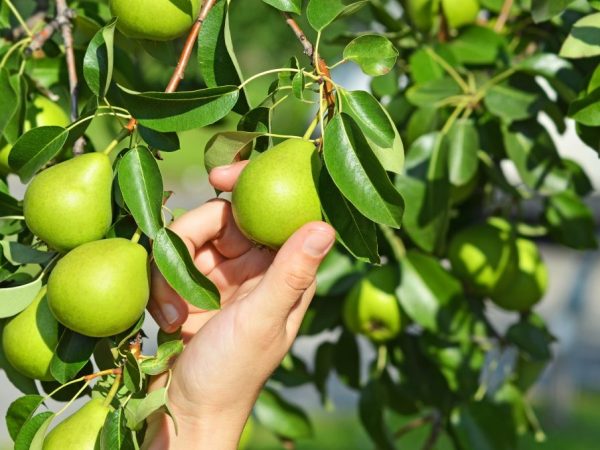
Full pear characteristic
Main characteristics
About 70 types of pears are known. Most varieties come from common or wild species. The common pear represents the pink family and has 3 varieties:
- forest;
- pear-shaped pear;
- Caucasian common pear.
To date, about 1000 varieties have been bred. In Russia, a fruit cultivated plant takes root best in the south, the Caucasus, in the middle lane. But there are also frost-resistant types of pears, for example, Ussuriyskaya. They can be grown in the Urals, Siberia, and the Far East.
Description of pear
The tree grows to a height of 10-25 m, there are varieties in the form of a large shrub. The crown of a pear can have a pyramidal or rounded shape, dense branches. The annual growth of branches is 30-40 cm. The pear has a straight trunk, up to 80 cm in diameter, covered with wrinkled dark bark. The wood is very hard and durable, with a yellowish tinge.
The leaves are ovoid, with pointed tips and small denticles along the edges. They grow on branches in a spiral of 5 rows. Their length is from 2.5 to 10 cm. From above they are shiny, saturated dark green. Below - matte, have a bluish tint. In autumn, the foliage turns golden yellow, and when the tree dries, it turns black.
Buds of 2 types: vegetative and generative (fruit). The first are small and pointed, the second are large, with blunt tips. Inflorescences are formed from last year's fruit buds.
Flowering period
The tree blooms even before full foliage appears, in early May or late April (a little earlier than the apple tree). This period lasts approximately 14-16 days. The flowers are white and rather large, about 3 cm in diameter, with 5 petals. They are collected in thyroid inflorescences, sitting close to each other. There are 2-5 pistils in one flower, there are a lot of stamens, they have a purple tint.
To achieve a good harvest, 2 mutually fertilized varieties should be planted side by side so that cross-pollination occurs. The main pollinator of the species is the bee. If you put an apiary in the garden, you can get not only a generous harvest, but also several kilograms of delicious honey.
Description of fruits
Pear fruits are very sweet, because contain a lot of sugar. The harvest ripens in August or September, depending on the variety. The fruits are oblong or slightly rounded. According to the botanical classification, the fruit of the pear fruit is called drupe or false berry. Color - from light yellow, almost white, to rich orange with red.
Fruiting of trees begins at the age of 7-8 years.It lasts 25-30 years, then the amount of the harvest drops. The age of the tree may be more, its average lifespan is 150-200 years, some even 300 years.
Pear composition
Description of the chemical composition ::
- Sugar or simple carbohydrates (fructose, glucose and sucrose) - 6-13%.
- Acids (malic, citric and ascorbic) - 0.12-0.19%.
- Pectins and tannins - 4%.
- Proteins - about 0.4%.
- Fat is about 0.1%.
- Minerals - 0.7%.
- Water - 80-84%.
- Energy value per 100 g of product - 42 kcal.
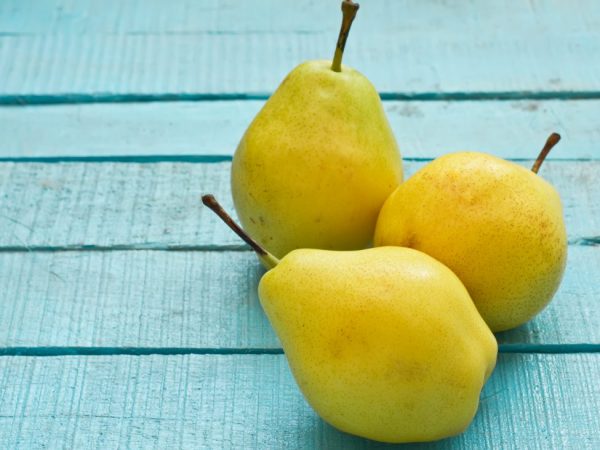
There are many vitamins in pear fruits
Pear also contains vitamins and minerals:
- B vitamins (B1, B2, B3, B5, B6, B9, or folic acid);
- Vitamin E;
- Vitamin A (carotene);
- Vitamin C;
- Potassium;
- Calcium;
- Magnesium;
- Sodium;
- Phosphorus;
- Small amounts of iron, iodine, manganese, cobalt, iodine, copper, fluorine, zinc, molybdenum
In many ways, the characteristics of pear fruits and their composition depend on the variety. The more essential oils, the better the scent. Wild varieties contain many tannins. Some fruits have small granules inside, which are woody cellulose. They are good for drying, but are of low value as tableware.
The benefits and uses of pears
The pear contains many useful substances, therefore it is very useful. Especially high content of potassium in fruits (mainly in the skin). They are recommended for people with high blood pressure, obesity, bowel disease. It is not advised to use this fruit for patients with ulcers, gastritis, pancreatitis, because it takes a long time to digest.
The pear contains a lot of iron, therefore it is advised for anemia. Juice mixed with rosehip decoction and honey treat colds and bronchitis. Fruits have a diuretic and antiseptic effect, therefore they are recommended for inflammatory diseases of the urinary system. To refresh the skin, use a pear cosmetic mask, which is easy to make at home.
The fruits of varietal pears are widely used in the food industry. They are dried, used for the production of juices, jams, preserves, marshmallows, marmalades, compotes. Manufacturers often combine different fruits. Very tasty and original juice brand "Ya" pear with banana and vanilla. You can also see juices in combination with apple, plum, grapes.
In the Caucasus, dried fruits are ground and added to flour, then flat cakes are baked from it. Certain types of seeds are roasted and made into coffee substitutes. An important area of application of fruit trees is the production of honey. From 1-1.5 hectares of plantations, up to 20-25 kg of this tasty product are obtained. The wood itself has a good value. It is used for the production and decoration of furniture, artistic carvings, floor coverings.
Planting pears
Before planting, you need to understand well where the pears grow so that the work does not go down the drain. The tree is light-loving and relatively thermophilic. For him, areas that are normally illuminated by the sun are suitable. It is better to choose places on a hill or on a hillside: in a cold lowland, trees do not develop well and give a meager harvest. The fruit loves moisture, but does not tolerate stagnant groundwater. The root system of an adult pear penetrates into the ground by 5-8 m. When the water level is raised, the roots rot. If a summer cottage or a house with a garden is located in a wet area, good drainage is made.
The soil for planting pears should be fertile and light. The tree is good for black soil, gray forest soil with a small amount of loam. Sandy and heavy clay soils are not suitable for this species.
How to choose the right pear? It is important to carefully examine the roots, they should not be dry or rotten. If you are planning a spring planting, and the material was bought in the fall, you can put it in storage at home in the basement, sprinkling the roots with sand or peat.
Landing rules
If a place is chosen where the pear grows best, proceed to planting. The culture is planted in autumn or spring.After planting in autumn (from mid-September to mid-October), the trees are stronger, less susceptible to disease, bear fruit better, but a young, immature pear may not withstand frost. In the spring, seedlings take root better in the northern regions, although there is a risk that diseases or pests will destroy them in the summer. The day of landing should be cloudy, someone is helped to determine the table of the lunar calendar.
A month before the autumn planting, a hole should be made. If it is decided to plant seedlings in the spring, the place must be prepared in the fall. The size of the pit is approximately 80 × 80 cm, the depth is about 1 m.A peg is driven into the center, which should protrude from the ground by 50 cm.The distance between small varietal trees should be 4-5 m, and between large trees - at least 6 m.
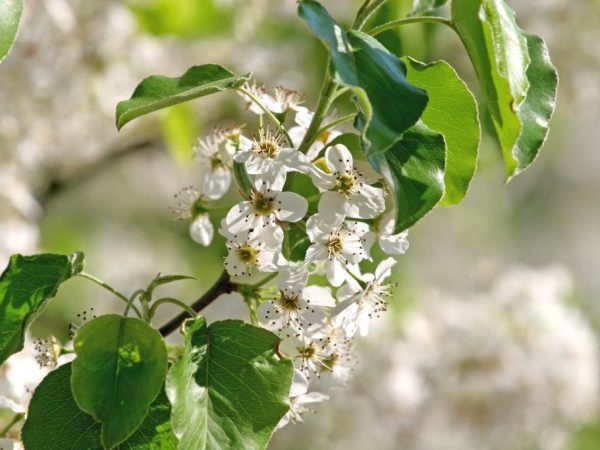
Plant your pear in a sunny spot
Fertilizers should be added to the ground:
- Compost, peat or rotted manure - 30 kg.
- Superphosphate - 1 kg.
- Potassium chloride - 100 g.
All ingredients are mixed. One part is carefully rammed in the pit, the second is poured into a small mound near the peg. The roots of the tree are slightly moistened in a solution of clay and immersed in a hole, from the north relative to the peg, then carefully sprinkled with fertile soil. Make sure not to completely lower the root collar into the ground: it should protrude 4-5 cm from the ground.
After planting is complete, young trees are watered with 2-3 buckets of water. When it is absorbed and the soil shrinks a little, sprinkle the ground with a layer of sawdust or humus 10 cm thick. The mulch should not touch the stem of the seedling. To prevent the tree from freezing in winter, it can be covered with spruce branches, pine branches and agricultural film. It is advisable to treat the covering material with anti-rodent agents.
Pear care
How to grow a pear correctly? The technology is simple. Each season has its own characteristics. Care measures begin with the removal of the covering film, and end with autumn feeding and preparation of trees for wintering. During the year, the gardener must take the following actions:
- spring and autumn pruning;
- top dressing;
- watering;
- fight against diseases and pests;
- shelter of young trees for the winter.
Let's take a closer look at how to grow a fruitful pear with the right care.
Pruning branches
Fruit tree pruning is done for several purposes:
- crown molding can be standard and trellis;
- sanitary pruning;
- rejuvenation of the old tree.
The crown begins to form in the spring of the first year. The scheme is simple, the top is cut off at a level of 50-70 cm from the ground. In the future, the branches are cut off every autumn, leaving 1-2 buds. Young pear shoots should grow at a 45 ° angle. If they are placed vertically, they can be bent down or placed on trellises.
Sanitary pruning during cultivation is carried out in the spring and fall. After winter, dried, frozen and diseased branches are removed. In the fall, you should shorten those shoots that bore fruit in the summer. A thickening of the crown is characteristic of a pear, therefore, it is advisable to thin it out before wintering. If pruning is done correctly, more fruit buds are formed next year and the yield of trees will increase. Extra branches can be used for rootstocks. One of the types of sanitary pruning is rejuvenating, with the removal of old branches.
Top dressing
For normal growth and good fruiting of a pear, 3-4 feeding is required per year. The first time this is done in early spring, until the buds swell. 80-120 g of urea is diluted in 5 liters of water and water the tree. Instead of urea, you can take nitrate at the rate of 30 g / m², the dry substance is diluted with water in a ratio of 1:50.
In May, you need organic food that stimulates growth during this growing season. First, the earth near the trunk is dug to a depth of 8-10 cm, then about 9 kg of humus is introduced there. If there is no organic matter, it is replaced with a nitroammophos. Fertilizer is diluted with water in a ratio of 1: 200 and 3 buckets of mixture are added under one tree. In June, you can carry out foliar feeding with nitrogen.
In autumn, it should be fed with minerals, fertilizers of the following composition are applied to the soil:
- 1 tbsp. l.potassium chloride;
- 2 tbsp. l. superphosphate granules;
- 10 liters of water.
All components are carefully bred, the trees are watered. Young seedlings can be fed with wood ash at the rate of 150 g per 1 m².
Watering
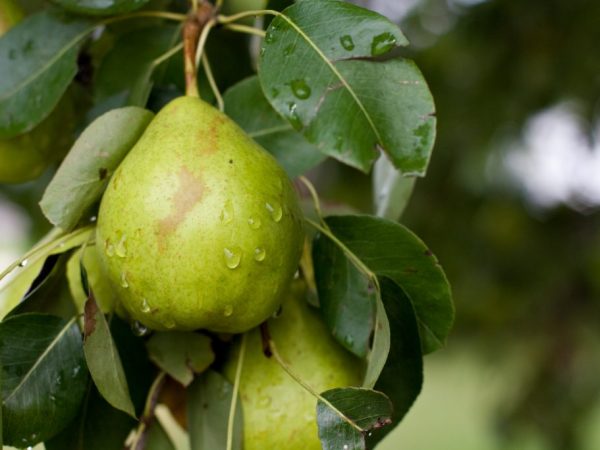
The pear needs moderate watering
The pear tree loves moisture, but does not tolerate stagnation of water at the roots, therefore it must be watered within reasonable limits. If the summer is moderately rainy and not very hot, 1 bucket per tree once a week is sufficient. During drought, you will need 3 buckets per week. This volume can be divided into 2 irrigations so that the water does not stagnate. It is best to water the trees in the evening, before sunset.
Disease prevention
In the spring, until the buds have blossomed, the tree must be sprayed with a urea solution (700 g / 10 l of water). When the foliage is blooming, the pear and the trunk are treated with biological preparations Fitoverm, Agravertin, Iskra-bio, Akarin. Well increase resistance to various pathologies "Zircon" and "Ekoberin".
Before wintering, trees must be protected from fungi and rodents. To do this, they are treated with Nitrofoskoy, Bordeaux liquid, antifungal drugs. The trunk of a pear can be simply whitewashed with slaked lime. All gardening tools must be clean.
Diseases of pears
Diseases of a different nature are characteristic of any pear, regardless of the variety. This is due to the low quality of planting material, poor care, soil contamination. However, people have not yet been able to completely defeat the diseases of fruit trees, therefore it is very important for novice gardeners to know their first symptoms in order to provide help in time. Diseases are most commonly caused by fungi, but viruses and bacteria can also cause disease.
Fungal diseases
According to the description of pears, the predisposing factors of fungal infections are improper processing before wintering, wet and cold summers. The fungus can get on the fruits from the soil, through the trunk and leaves, and also be carried by insects from other plants. The source can be a weed or a parasite on a pear, garden tools. For treatment and prevention, trees are treated with 1% Bordeaux liquid, lime, nitrophos, fungicides. Fallen leaves must be burned. The most common diseases are:
- Scab. Caused by the fungus Fusicladium pirinum. First, large olive dots appear on the leaves. Then the fruits are affected, they become covered with putrefactive spots, the shape becomes asymmetric, the peel cracks, the pulp hardens.
- Fruit rot. The disease is caused by the mushroom Monilia fructigena. Infected pears rot right on the branch. Then, light concentric growths appear on their surface. The fungus is carried by insects, and can infect all fruit trees in the garden with the pear.
- Sooty fungus (Fumago vagans Pers). The leaves and fruits are covered with a black bloom, very reminiscent of soot. Most often, the disease occurs in the second half of summer, when the fruits ripen. At this time, a favorable environment for the growth of the pathogen is created on their surface.
- Powdery mildew is caused by the fungus Erysiphales. In early spring, a white bloom appears on young twigs and leaves, and soon the tree sheds them.
- Leaf rust is caused by fungi of the genus Pucciniaceae. On fruits and foliage, spots appear first yellow and then rusty orange.
- Black cancer, or "Antonov fire" (Sphaeropsis malorum Peck). The disease can kill an entire tree. First, the bark turns black, as if burnt, then the foliage dries up and crumbles, the ovary does not form. If the pear dies, it is burned.
- Cytosporosis. The causative agent is Cytospora leucostoma. The bark in some places becomes brown-orange, like a mushroom capita. Then leaves and fruits begin to dry, young shoots die.
Bacterial diseases
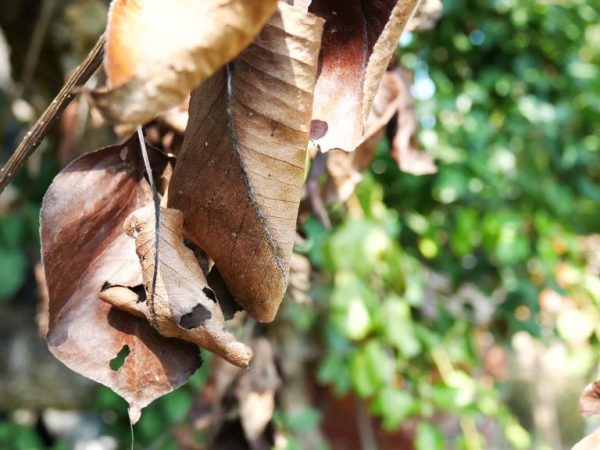
Disease can kill a tree
Bacterial diseases are even more dangerous than fungal diseases. It is difficult to fight them, often trees die. Here are the most common pathologies in this group:
- The bacterial burn is caused by the microorganism Erwinia amylovora.First, pear flowers are affected, they become brown, curl, dry out, do not pollinate, but do not fall off either. Then the leaves turn black, the stem part is affected. To combat pathology, branches that have darkened should be cut off, capturing 15-20 cm of a healthy tree.
- Root cancer. Another bacteriosis that causes Agrobacterium tumefaciens. The disease is transmitted with seedlings and can persist in the soil for several years.
Viral diseases
Viral diseases are less common than fungal and bacterial ones, but it is almost impossible to fight them. Most often, trees are detected:
- Subcutaneous spotting. First, multi-colored spots appear on the leaves. The fruits are deformed, dents are visible on their surface. Hard areas are found inside. The bark of the tree is cracking.
- Mosaic ringing. With this disease, rings of a pale green color appear on the leaves, resembling chlorosis, over time they become brown or bronze. The foliage dries up and falls off, the fruits become small, fall to the ground even before ripening.
Viral diseases have ruined many plantings, so you need to be careful about the choice of seedlings.
Popular varieties of pears
Varieties differ in size and shape of fruits, taste, sugar content, frost resistance. There are species that grow like a shrub, tall or low, with a wide or narrowed crown. According to the ripening period, the varieties are divided into early, medium and late. Listed below are some varieties of pears and a description of their main qualities.
Early varieties
These varieties ripen in June-July. They often have small fruits and a soft, tender heart. The shelf life of early summer varieties is very short, but selection is being carried out to eliminate the deficiency. Here are some names of varieties of pears in this group:
- Lipotics. The fruits are golden, with red barrels, the pulp is juicy and aromatic, without grains, melts in the mouth. The variety is resistant to scab, is not affected by aphids, does not tolerate cold well.
- Early summer. The pears are small, weighing about 1200 g, with a yellow skin and white flesh. Sweet and sour, stored for only 10 days.
- Early Moldavian. Hybrid variety, fruits weigh about 150 g, yellow-green with creamy buttery pulp. They have a rich aroma and sweet-sour taste.
- July early. Fruits are elongated, yellow in color, juicy, sweet and sour in taste. The variety ripens in mid-July, tolerates cold winters well.
- Refectory. Delicious and aromatic early ripening variety, shelf life only 5 days.
Medium varieties
These varieties ripen from late August to late September. They are juicy and sweet and have a medium shelf life. Here are some popular varieties:
- Veles variety. This pear has a fruit weighing about 200 g. The pulp is tasty and creamy. Trees tolerate winter well and are resistant to many diseases.
- Elegant Efimova. It ripens in September, has a yellow-green peel and creamy pulp, weighs about 120 g. Stored in the refrigerator for 2-3 weeks, if not fully ripe.
- Thumbelina. Winter-hardy variety with small fruits (weight about 80 g). The color of the peel is yellow-brown, the fruits can be stored until the end of December. The height of the pear is medium, so harvesting is very convenient.
- Pear Autumn favorite. The fruits are rather large, about 170 g, green-yellow in color with greenish flesh. The skin is thin, the taste is wine-sweet, the aroma is weak.
- Margarita Marilya. A variety with very large fruits weighing 250-350 g (some can weigh up to 700 g). The surface of the skin is bumpy, golden color with a pink barrel. The pulp with a yellow tint, small grains, juicy and sweet in taste, with a subtle nutmeg smell.
Late varieties
These varieties ripen at the end of September or October, but such winter varieties can be stored for several months. The fruits are picked green and left in a cool place to ripen. Here are some representatives of winter varieties:
- Bere Bosk. The fruit of the pear is oblong, green when harvested, bronze-brown after laying.The taste is delicate, sweet, the fruit is stored for 1.5-2 months in the refrigerator.
- Bere Ardanpon. Large fruits weigh about 300 g, have a bumpy surface, green-yellow in color, somewhat reminiscent of a quince. The pulp is oily and sweet, you can harvest in early October, and store until January.
- Dikanka is winter. This pear is characterized by a barrel-shaped fruit, the fruits weigh up to 300 g. The color of the fruits when harvested is green with a red blush. After a couple of weeks, they turn golden yellow. The crop is harvested from the trees in mid-October, it is stored until the end of February or until March. The flavoring properties of pear are excellent, it is sweet and juicy.
- Belarusian late. The tree begins to bear fruit within 4 years after planting. When fully ripe, the pear is yellow-orange, but harvested still green. The pulp is white with a sweet and sour taste. According to the shelf life, this is pear number 1, it can lie until March.
- Rossoshanskaya late. This variety has good frost resistance, large fruits, weighing up to 350 g. They are harvested green at the end of September, after a couple of weeks they turn yellow, stored for 3-4 months, overripe - no more than 3 weeks. The pulp is juicy, creamy, sweet in taste.
The beneficial properties of pears do not depend on varieties. You can buy any you like. The main thing is that it is suitable for the climatic zone. The last point is very important to get a good harvest. For example, the Chinese pear does not take root well in our conditions, but many European summer and winter varieties are now well adapted to the conditions of the Moscow region, the Volga region and colder regions.


